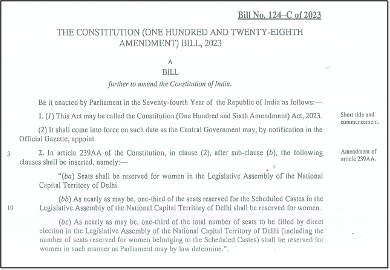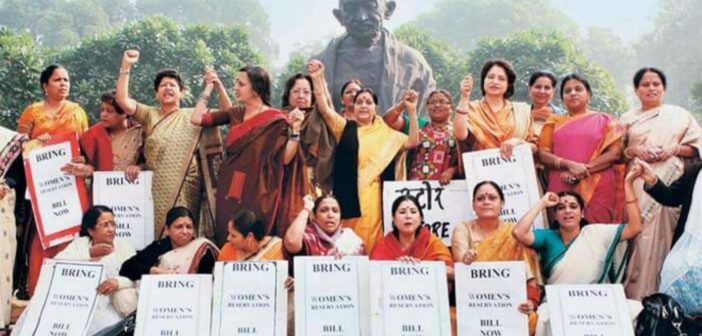With the passage of Women’s Reservation Bill, to be implemented post new Census Data & Delimitation, the number & share of Women MPs & MLAs is expected to significantly increase. But what has been the trend in the share of women MPs & contestants over the years?
In the special session of the Parliament of India held from 18 to 22 September 2023, the Constitution (One Hundred and Twenty-Eighth Amendment) Bill, 2023 was passed by both the Houses. The Women’s Reservation Bill which is also referred to as Nari Shakti Vandan Adhiniyam aims to reserve 33% seats for women in Lok Sabha and state Legislative Assemblies. The same is also applicable to the seats reserved for SCs and STs in Lok Sabha and state legislatures. It was approved by the Rajya Sabha after a division vote in which 214 members voted in favour of the Bill while none voted against it. The Lok Sabha also passed the Bill with near unanimous support.
It is also the first bill to have been passed in the new Parliament building. The passage of the Bill has been considered “a defining moment in our nation’s democratic journey!” by the Prime Minister in his tweet. UN Women also hailed India’s passage of the Women’s Reservation Bill and added that India is one of 64 countries around the world that have reserved seats for women in their national Parliaments.
In this story, we delve into the statistics concerning women’s representation in the Lok Sabha. In the subsequent part of the story, we look at the data about women’s representation in state assemblies across India.

The Bill will be effective after the Census data is published & delimitation taken up
The 33% reservation for women will be effective after the census data for the proposed 2021 is published. This will be followed by delimitation or fixing boundaries for constituencies for Lok Sabha and State Assembly constituencies on the basis of the Census to reserve seats for women. The reservation will be provided for an initial period of fifteen years. Nonetheless, it would continue till such a date as determined by a law made by Parliament. Furthermore, the seats reserved for women will be rotated after each delimitation, as determined by a law made by Parliament.
The 73rd and 74th Amendments passed in 1993, which devolved multiple functions to the rural & urban local bodies, reserve one-third of seats for women in these bodies to enhance women’s involvement in decision-making processes at the grassroots level. The Constitution also provides for the reservation of seats in Lok Sabha and state legislative assemblies for Scheduled Castes (SCs) and Scheduled Tribes (STs) in proportion to their population. However, the Constitution does not provide for the reservation of seats for women in the Lok Sabha and state legislative assemblies. Since then, Bills for amending the Constitution for this purpose have been introduced multiple times but failed to pass, until 2023.
India had highest number of women MPs in Lok Sabha in 2019
As per the Women and Men in India report, 2020, from the second Lok Sabha in 1957 that had 27 women MPs, the number of women MPs has increased almost three times to 78 in the current Lok Sabha. (Data categorized by sex is not available for the first Lok Sabha). 2019 saw the highest number of women MPs in the Lower House of the Parliament. Including 31 Rajya Sabha members, India has more than 100 women MPs in the Parliament.
14.4% of MPs are women in Lok Sabha
In terms of both number and share, the rise in numbers has been steady over the 7 decades. The share of women MPs has increased from about 5.5% in 1957 to 14.4% in 2019. Since 2009, the share has been above 10%. There is a marked and steady increase from 1991 onwards to the present Lok Sabha, except for a dip during the 14th Lok Sabha (2004).
As of 09 December 2022, the percentage share of women elected to the Lok Sabha stood higher than the national average share of women elected to state assemblies, according to a parliament response. The share of women elected to state assemblies was lower than 14% in 30 out of 31 states/UTs. Only Chhattisgarh (2018) had a representation of more than 14%. The year of the last General Election to the Legislative Assembly was considered to calculate the percentage share of seats won by women. These figures are way lower than the 33% proposed in the Bill.
Women contestants in elections have increased 16-fold since 1957
Women’s participation in the elections to the Lower House has improved over the years. In 1957, only about 45 women had contested in the elections while in 2019, the number was 724, the highest ever. This is a 16-fold increase. During the same period, the number of men who contested rose nearly 5 times from 1,473 to 7,296.
Winning share of women has always been higher than their male counterparts
The winning share of women is the number of women who won the elections against the total number of women contestants. Likewise, for men, it is the number of men who won elections against the number of men who contested.
The winning share of women has always been higher than that of men. The winning share for women was 60% in 1957. That is 6 out of 10 women who had contested won the elections. For men, it was around 31%. The winning share for women was 50% in the subsequent elections held in 1962 and 24% for men. In the 1984 elections, the winning share for women was almost 3 times that of men. However, the winning share has dropped gradually for both men and women as more & more people started contesting elections. In the last 3 elections – 2009, 2014, and 2019, the winning share for men has been around 6% while it was about 10% for women. This indicates that women either had a better chance of winning from the seats that they stood from, or women were given tickets where they had a higher chance of winning.
Women’s parliamentary representation is critical for gender equality
Women’s representation in parliament is a crucial step forward for empowering women, achieving gender equality, promoting social justice, and addressing a wide range of issues that impact both women and society as a whole. With respect to women’s representation in the Lok Sabha, there has been considerable improvement over the years. However, despite women making up roughly half the population, their representation in the parliament is still low. The recent bill will hopefully change this.



